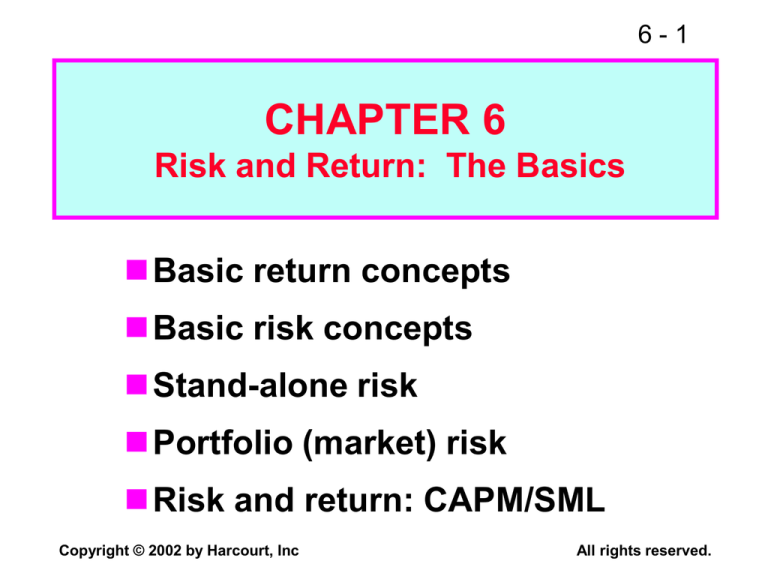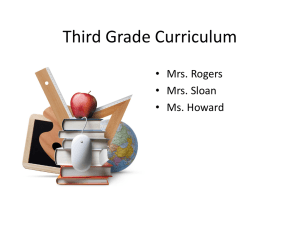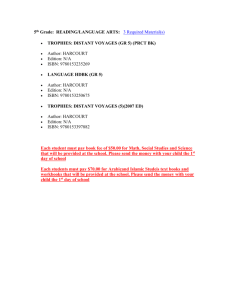CHAPTER 6
advertisement

6-1 CHAPTER 6 Risk and Return: The Basics Basic return concepts Basic risk concepts Stand-alone risk Portfolio (market) risk Risk and return: CAPM/SML Copyright © 2002 by Harcourt, Inc All rights reserved. 6-2 What are investment returns? Investment returns measure the financial results of an investment. Returns may be historical or prospective (anticipated). Returns can be expressed in: Dollar terms. Percentage terms. Copyright © 2002 by Harcourt, Inc All rights reserved. 6-3 What is the return on an investment that costs $1,000 and is sold after 1 year for $1,100? Dollar return: $ Received - $ Invested $1,100 $1,000 = $100. Percentage return: $ Return/$ Invested $100/$1,000 = 0.10 = 10%. Copyright © 2002 by Harcourt, Inc All rights reserved. 6-4 What is investment risk? Typically, investment returns are not known with certainty. Investment risk pertains to the probability of earning a return less than that expected. The greater the chance of a return far below the expected return, the greater the risk. Copyright © 2002 by Harcourt, Inc All rights reserved. 6-5 Probability distribution Stock X Stock Y -20 0 15 50 Rate of return (%) Which stock is riskier? Why? Copyright © 2002 by Harcourt, Inc All rights reserved. 6-6 Assume the Following Investment Alternatives Economy Prob. T-Bill HT Coll USR MP Recession 0.10 8.0% -22.0% 28.0% 10.0% -13.0% Below avg. 0.20 8.0 -2.0 14.7 -10.0 1.0 Average 0.40 8.0 20.0 0.0 7.0 15.0 Above avg. 0.20 8.0 35.0 -10.0 45.0 29.0 Boom 0.10 8.0 50.0 -20.0 30.0 43.0 1.00 Copyright © 2002 by Harcourt, Inc All rights reserved. 6-7 What is unique about the T-bill return? The T-bill will return 8% regardless of the state of the economy. Is the T-bill riskless? Explain. Copyright © 2002 by Harcourt, Inc All rights reserved. 6-8 Do the returns of HT and Collections move with or counter to the economy? HT moves with the economy, so it is positively correlated with the economy. This is the typical situation. Collections moves counter to the economy. Such negative correlation is unusual. Copyright © 2002 by Harcourt, Inc All rights reserved. 6-9 Calculate the expected rate of return on each alternative. ^ k = expected rate of return. k = n k P. i i i=1 ^ kHT = 0.10(-22%) + 0.20(-2%) + 0.40(20%) + 0.20(35%) + 0.10(50%) = 17.4%. Copyright © 2002 by Harcourt, Inc All rights reserved. 6 - 10 HT Market USR T-bill Collections ^ k 17.4% 15.0 13.8 8.0 1.7 HT has the highest rate of return. Does that make it best? Copyright © 2002 by Harcourt, Inc All rights reserved. 6 - 11 What is the standard deviation of returns for each alternative? Standard deviation Variance k n i 1 Copyright © 2002 by Harcourt, Inc 2 2 i k̂ Pi . All rights reserved. 6 - 12 k n i 1 2 i k̂ Pi . HT: = ((-22 - 17.4)20.10 + (-2 - 17.4)20.20 + (20 - 17.4)20.40 + (35 - 17.4)20.20 + (50 - 17.4)20.10)1/2 = 20.0%. T-bills = 0.0%. HT = 20.0%. Copyright © 2002 by Harcourt, Inc Coll = 13.4%. USR = 18.8%. M = 15.3%. All rights reserved. 6 - 13 Prob. T-bill US R 0 8 13.8 Copyright © 2002 by Harcourt, Inc 17.4 HT Rate of Return (%) All rights reserved. 6 - 14 Standard deviation measures the stand-alone risk of an investment. The larger the standard deviation, the higher the probability that returns will be far below the expected return. Coefficient of variation is an alternative measure of stand-alone risk. Copyright © 2002 by Harcourt, Inc All rights reserved. 6 - 15 Expected Return versus Risk Security HT Market USR T-bills Collections Expected return 17.4% 15.0 13.8 8.0 1.7 Risk, 20.0% 15.3 18.8 0.0 13.4 Which alternative is best? Copyright © 2002 by Harcourt, Inc All rights reserved. 6 - 16 Portfolio Risk and Return Assume a two-stock portfolio with $50,000 in HT and $50,000 in Collections. ^ Calculate kp and p. Copyright © 2002 by Harcourt, Inc All rights reserved. 6 - 17 ^ Portfolio Return, kp ^ kp is a weighted average: n ^ ^ kp = wiki i=1 ^ kp = 0.5(17.4%) + 0.5(1.7%) = 9.6%. ^ ^ ^ kp is between kHT and kColl. Copyright © 2002 by Harcourt, Inc All rights reserved. 6 - 18 Alternative Method Estimated Return Economy Recession Below avg. Average Above avg. Boom Prob. 0.10 0.20 0.40 0.20 0.10 HT -22.0% -2.0 20.0 35.0 50.0 Coll. 28.0% 14.7 0.0 -10.0 -20.0 Port. 3.0% 6.4 10.0 12.5 15.0 ^ kp = (3.0%)0.10 + (6.4%)0.20 + (10.0%)0.40 + (12.5%)0.20 + (15.0%)0.10 = 9.6%. (More...) Copyright © 2002 by Harcourt, Inc All rights reserved. 6 - 19 p = ((3.0 - 9.6)20.10 + (6.4 - 9.6)20.20 + (10.0 - 9.6)20.40 + (12.5 - 9.6)20.20 + (15.0 - 9.6)20.10)1/2 = 3.3%. p is much lower than: either stock (20% and 13.4%). average of HT and Coll (16.7%). The portfolio provides average return but much lower risk. The key here is negative correlation. Copyright © 2002 by Harcourt, Inc All rights reserved. 6 - 20 Two-Stock Portfolios Two stocks can be combined to form a riskless portfolio if r = -1.0. Risk is not reduced at all if the two stocks have r = +1.0. In general, stocks have r 0.65, so risk is lowered but not eliminated. Investors typically hold many stocks. What happens when r = 0? Copyright © 2002 by Harcourt, Inc All rights reserved. 6 - 21 What would happen to the risk of an average 1-stock portfolio as more randomly selected stocks were added? p would decrease because the added stocks would not be perfectly correlated, but ^ kp would remain relatively constant. Copyright © 2002 by Harcourt, Inc All rights reserved. 6 - 22 Prob. Large 2 1 0 15 Return 1 35% ; Large 20%. Copyright © 2002 by Harcourt, Inc All rights reserved. 6 - 23 p (%) Company Specific (Diversifiable) Risk 35 Stand-Alone Risk, p 20 Market Risk 0 10 20 30 40 2,000+ # Stocks in Portfolio Copyright © 2002 by Harcourt, Inc All rights reserved. 6 - 24 Stand-alone Market Diversifiable = risk + . risk risk Market risk is that part of a security’s stand-alone risk that cannot be eliminated by diversification. Firm-specific, or diversifiable, risk is that part of a security’s stand-alone risk that can be eliminated by diversification. Copyright © 2002 by Harcourt, Inc All rights reserved. 6 - 25 Conclusions As more stocks are added, each new stock has a smaller risk-reducing impact on the portfolio. p falls very slowly after about 40 stocks are included. The lower limit for p is about 20% = M . By forming well-diversified portfolios, investors can eliminate about half the riskiness of owning a single stock. Copyright © 2002 by Harcourt, Inc All rights reserved. 6 - 26 Can an investor holding one stock earn a return commensurate with its risk? No. Rational investors will minimize risk by holding portfolios. They bear only market risk, so prices and returns reflect this lower risk. The one-stock investor bears higher (stand-alone) risk, so the return is less than that required by the risk. Copyright © 2002 by Harcourt, Inc All rights reserved. 6 - 27 How is market risk measured for individual securities? Market risk, which is relevant for stocks held in well-diversified portfolios, is defined as the contribution of a security to the overall riskiness of the portfolio. It is measured by a stock’s beta coefficient, which measures the stock’s volatility relative to the market. What is the relevant risk for a stock held in isolation? Copyright © 2002 by Harcourt, Inc All rights reserved. 6 - 28 How are betas calculated? Run a regression with returns on the stock in question plotted on the Y axis and returns on the market portfolio plotted on the X axis. The slope of the regression line, which measures relative volatility, is defined as the stock’s beta coefficient, or b. Copyright © 2002 by Harcourt, Inc All rights reserved. 6 - 29 Use the historical stock returns to calculate the beta for KWE. Year 1 2 3 4 5 6 7 8 9 10 Copyright © 2002 by Harcourt, Inc Market 25.7% 8.0% -11.0% 15.0% 32.5% 13.7% 40.0% 10.0% -10.8% -13.1% KWE 40.0% -15.0% -15.0% 35.0% 10.0% 30.0% 42.0% -10.0% -25.0% 25.0% All rights reserved. 6 - 30 Calculating Beta for KWE 40% kKWE 20% kM 0% -40% -20% 0% 20% 40% -20% -40% Copyright © 2002 by Harcourt, Inc kKWE = 0.83kM + 0.03 R2 = 0.36 All rights reserved. 6 - 31 How is beta calculated? The regression line, and hence beta, can be found using a calculator with a regression function or a spreadsheet program. In this example, b = 0.83. Analysts typically use four or five years’ of monthly returns to establish the regression line. Some use 52 weeks of weekly returns. Copyright © 2002 by Harcourt, Inc All rights reserved. 6 - 32 How is beta interpreted? If b = 1.0, stock has average risk. If b > 1.0, stock is riskier than average. If b < 1.0, stock is less risky than average. Most stocks have betas in the range of 0.5 to 1.5. Can a stock have a negative beta? Copyright © 2002 by Harcourt, Inc All rights reserved. 6 - 33 Expected Return versus Market Risk Security HT Market USR T-bills Collections Expected return 17.4% 15.0 13.8 8.0 1.7 Risk, b 1.29 1.00 0.68 0.00 -0.86 Which of the alternatives is best? Copyright © 2002 by Harcourt, Inc All rights reserved. 6 - 34 Use the SML to calculate each alternative’s required return. The Security Market Line (SML) is part of the Capital Asset Pricing Model (CAPM). SML: ki = kRF + (RPM)bi . Assume kRF = 8%; ^kM = kM = 15%. RPM = (kM - kRF) = 15% - 8% = 7%. Copyright © 2002 by Harcourt, Inc All rights reserved. 6 - 35 Required Rates of Return kHT = 8.0% + (7%)(1.29) = 8.0% + 9.0% kM = 15.0%. kUSR = 12.8%. kT-bill = kColl = = 17.0%. 8.0% + (7%)(1.00) = 8.0% + (7%)(0.68) = 8.0% + (7%)(0.00) = 8.0% + (7%)(-0.86) = Copyright © 2002 by Harcourt, Inc 8.0%. 2.0%. All rights reserved. 6 - 36 Expected versus Required Returns ^k HT 17.4% k 17.0% Undervalued Market 15.0 15.0 Fairly valued USR 13.8 12.8 Undervalued T-bills 8.0 8.0 Fairly valued Coll 1.7 2.0 Overvalued Copyright © 2002 by Harcourt, Inc All rights reserved. 6 - 37 ki (%) SML: ki = kRF + (RPM) bi ki = 8% + (7%) bi . HT kM = 15 kRF = 8 . . . . T-bills Market USR Coll. -1 0 1 2 Risk, bi SML and Investment Alternatives Copyright © 2002 by Harcourt, Inc All rights reserved. 6 - 38 Calculate beta for a portfolio with 50% HT and 50% Collections bp = Weighted average = 0.5(bHT) + 0.5(bColl) = 0.5(1.29) + 0.5(-0.86) = 0.22. Copyright © 2002 by Harcourt, Inc All rights reserved. 6 - 39 What is the required rate of return on the HT/Collections portfolio? kp = Weighted average k = 0.5(17%) + 0.5(2%) = 9.5%. Or use SML: kp = kRF + (RPM) bp = 8.0% + 7%(0.22) = 9.5%. Copyright © 2002 by Harcourt, Inc All rights reserved. 6 - 40 Impact of Inflation Change on SML Required Rate of Return k (%) I = 3% New SML SML2 SML1 18 15 11 8 Original situation 0 0.5 Copyright © 2002 by Harcourt, Inc 1.0 1.5 2.0 All rights reserved. 6 - 41 Impact of Risk Aversion Change Required Rate of Return (%) After increase in risk aversion SML2 kM = 18% kM = 15% SML1 18 RPM = 3% 15 8 Original situation 1.0 Copyright © 2002 by Harcourt, Inc Risk, bi All rights reserved. 6 - 42 Has the CAPM been verified through empirical tests? No. The statistical tests have problems that make empirical verification virtually impossible. Investors may be concerned about both stand-alone risk and market risk. Furthermore, investors’ required returns are based on future risk, but betas are based on historical data. Copyright © 2002 by Harcourt, Inc All rights reserved.






